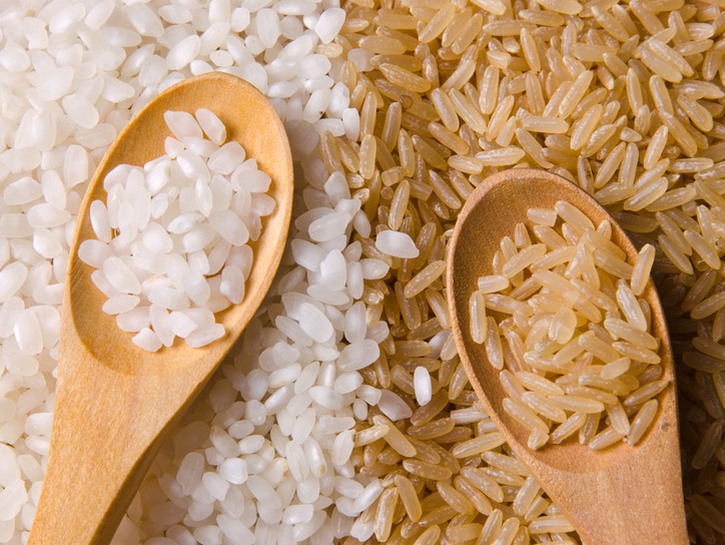Rice is a filling and versatile grain using in many dishes around the world. It comes in many types and colors, but the most commonly used kinds are brown and white rice. The debate on which is healthier has been ongoing with some believing that brown rice is superior while others assert that both yield the same benefits. Here we will break down the difference between these dueling grains.
Nutritional Breakdown: Brown Rice vs. White Rice
All rice is comprised of almost all carbs with minimal amounts of protein and no fat. Brown rice is considered a whole grain which means that contains all parts of the grain–the germ, bran and the endosperm. Specifically, the bran and the germ are the most nutritious parts of the grain. Unfortunately, these parts are removed from white rice. Thus, leaving white rice with significantly fewer nutrients than brown rice. Let’s compare their nutritional difference more in-depth.
In comparison to a 1/2 cup serving of white rice, one serving of brown rice has 50% more protein, 105% more fiber, and 425% more omega-3 fatty acids. That’s quite the difference! To break it down further:

Fiber
Brown rice has about 1 to 3g more fiber than white rice. We all are familiar with the health benefits of fiber including reduced risk of heart disease, lower cholesterol, and stabilized blood sugar levels.
Iron
A 1/2 cup of white rice has 40% less iron than brown rice. Iron is an essential mineral that is a part of hemoglobin, a protein that transfers oxygen from the lung to the tissues.
Potassium
Brown rice is rich in potassium– one serving has 182 mg. White rice is lacking this vitamin completely. A diet high in potassium reduces the risk of stroke, lowers blood pressure, and preserves bone mineral density.
Magnesium
Unlike its counterpart, brown rice is a great source of magnesium. One 1/2 cup of brown rice contains 42 mg of magnesium. This macromineral helps to plays a key role in maintaining the health of your muscles and bones.
Brown Rice Vs. White Rice: Glycemic Index
The glycemic index is a ranking of carbohydrates in foods according to its impact on blood sugar levels. Foods with a high GI tend to spike blood glucose levels. Both white and brown rice have a pretty high glycemic index score. Brown rice has a score of 68, while white rice has a score of 73. This means that brown rice affects your blood sugar at a slower rate. Brown rice would be a better option for those with diabetes or insulin sensitivity.
Rice Risks of Antinutrients
Antinutrients are compounds that inhibit the body’s ability to absorb nutrients. Brown rice contains the antinutrient phytic acid which reduces your body’s ability to absorb iron and zinc. To deplete the amount of phytic acid in brown rice, it is recommended that you steam or soak it.

Another controversial topic surrounding brown rice is its level of arsenic, a toxic substance. Arsenic is a heavy metal that is present in the environment, but due to pollution, its levels have increased significantly. Rice collects more arsenic than any other food crop. Particularly, brown rice has 80% more inorganic arsenic than white rice. The health effects of consuming arsenic include numerous types of cancers, high blood pressure, heart disease, and type 2 diabetes. As horrifying as all that sounds, there is a way to reduce arsenic content of rice. Washing and cooking it in water that is low of arsenic has been shown to decrease its content by 57%.
In order to help reduce further exposure, be sure to follow these tips:
- Choose white or aromatic varieties of rice, like jasmine or basmati, over brown rice.
- Children and pregnant women should consume limited portions of rice.
- Rinse rice before cooking.
- Select rice that is grown in the Himalayan region.
- Avoid rice grown during the dry season.
Other Health Benefits Of Brown Rice
Heart Disease Prevention
Brown rice contains plant lignans compounds that help to reduce the risk of heart disease. They have been shown to decrease the amount of fat in the blood, reduce inflammation in the arteries, and lower blood pressure. A study found that people who ate whole grains lowered their risk of heart disease by 16-21%.
Weight Loss
Although brown rice has a few more calories than white rice, eating brown rice instead of white has been associated with a smaller waistline. It is suggested that consuming brown rice can reduce BMI and weight.
Bottom Line
Considering its health benefits and nutritional value, brown rice is healthier than white rice. However, contrary to believe white rice isn’t the devil per se. It isn’t inherently “bad for you,” it just has minimal vitamins and minerals compared to its more whole counterpart brown rice. If you’re still not a fan of either, there are other whole grains and nutritious substitutes including quinoa and barley.

Prepare Your Rice Perfectly At Home
Boil it.
Treat it like pasta. After adding rice to the boiling water, stir right away so it doesn’t stick to the bottom. White long-grain rice takes about 12 minutes and for brown long-grain rice it takes about 35 minutes.
Bake it.
Preheat your oven to 325 degrees. Butter a 2 1/2-quart baking dish and pour rice into the prepared baking dish. Stir water, butter, and salt in a saucepan and bring to boil. Bake in preheated oven until the water is absorbed and the rice is tender (20 to 25 minutes).
Steam it.
Bring water to boil in a saucepan. Stir in white rice and salt. Reduce heat and simmer while covered for about 16 minutes. Remove from the heat and let stand covered for 10 minutes.
